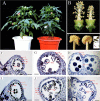Defective pollen wall contributes to male sterility in the male sterile line 1355A of cotton
- PMID: 26043720
- PMCID: PMC4456728
- DOI: 10.1038/srep09608
Defective pollen wall contributes to male sterility in the male sterile line 1355A of cotton
Abstract
To understand the mechanisms of male sterility in cotton (Gossypium spp.), combined histological, biochemical and transcription analysis using RNA-Seq was carried out in the anther of the single-gene recessive genic male sterility system of male sterile line 1355A and male fertile line 1355B, which are near-isogenic lines (NILs) differing only in the fertility trait. A total of 2,446 differentially expressed genes were identified between the anthers of 1355AB lines, at three different stages of development. Cluster analysis and functional assignment of differentially expressed genes revealed differences in transcription associated with pollen wall and anther development, including the metabolism of fatty acids, glucose, pectin and cellulose. Histological and biochemical analysis revealed that a major cellular defect in the 1355A was a thicker nexine, consistent with the RNA-seq data, and further gene expression studies implicated differences in fatty acids synthesis and metabolism. This study provides insight into the phenotypic characteristics and gene regulatory network of the genic male sterile line 1355A in upland cotton.
Figures





References
-
- Tang W. Study on morphological, cytological and biochemical characteristics in anthers of recessive genetic sterile line of upland cotton (Gossypium hirsutum L.). Master degree thesis, Sichuan Agricultural University, Ya an, (2008).
-
- Wang G., Guo X. & Zhang X. Sterile stability of four genetic male sterile lines and genetic male sterile gene localization in 1355A. Journal of Huazhong Agricultural University 25, 351–354 (2006).
-
- Wiermann R., Ahlers F. & Schmitz-Thom I. [Sporopollenin]. Biopolymers Vol. 1 [Stenbuchel A., & Hofrichter M., eds. (eds.)] [209–227] (Wiley-VCH Verlag, Weinheim, 2001).
-
- Ahlers F., Thom I., Lambert J., Kuckuk R. & Rolf W. 1H NMR analysis of sporopollenin from Typha Angustifolia. Phytochemistry 50, 1095–1098 (1999).
Publication types
MeSH terms
LinkOut - more resources
Full Text Sources
Other Literature Sources
Miscellaneous

